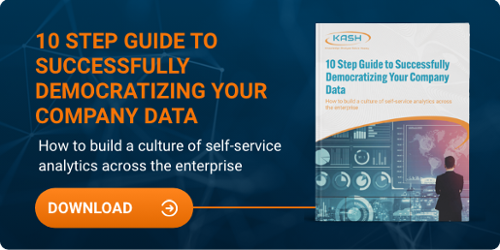A Guide to Augmented Analytics and High-Tech Data Solutions for Your Business
Topic:
Democratizing Data
Let’s begin the discussion by answering the question: what is augmented analytics? A basic definition of augmented analytics is a class of data analytics powered by artificial intelligence (AI) and machine learning (ML) that expands a human’s ability to interact with data at a contextual level.
In reality, augmented analytics is far more than just that. Augmented analytics uses automation to analyze big datasets typically done by a data scientist. This analytics process makes data preparation and natural language processing accessible to any type or size of business and energizes data-driven decisions throughout the organization.
Augmented analytics has the power to propel your business to the front of the pack when it comes to increased efficiency, better products and distribution, increased customer satisfaction, competitive advantage, happier employees, greater market share, and increased profits. Does that sound inviting? Then keep reading to find out more.
How Can Augmented Analytics Enhance Business Intelligence?
According to the Business Application Research Center (BARC) survey and reported by bi-survey.com:
- 58% of the respondents say their companies base at least half of their decisions on hunches and experience rather than hardcore metrics.
- …“best-in-class” companies base their decisions more on information (60%), while “laggard” companies base a worryingly high 70% of their decisions on gut feel.
Hunches and gut feelings may work in smaller, start-up types of businesses where team members have an intricate knowledge of all aspects of the company from the ground up. But in larger or more mature organizations, team members become specialized and focus on more targeted elements of the business.
As a result, hunches and gut feelings are watered down by a lack of tribal knowledge and silos that hinder communication and understanding. That is where the benefit of augmented analytics takes center stage by eliminating hunches and gut feelings from the organization's decision-making processes and replacing them with data-based intelligence and actionable insights.
What is an Artificial Intelligence (AI) Algorithm?
At its most basic, an algorithm is the set of instructions needed to execute a calculation or operation and can apply to mathematics and computer science. Artificial intelligence could not exist without these instructions, so the algorithm is the core aspect of Artificial Intelligence. There are two types of algorithms: static and dynamic.
- A static algorithm remains constant, responds similarly to new input data, and requires a programmer to change its instructions and output.
- A dynamic algorithm is designed and programmed to learn as it completes assigned instructions against the increasing data that it processes. As it processes new data, it can adjust its instructions to consider attributes of the new data not previously encountered, test its output, and adjust its instruction set to achieve the optimum result from the data provided.
What are the Most Common Types of Artificial Intelligence and Machine Learning Algorithms?
Supervised learning is an approach to augmented analytics that uses “labeled datasets” (data that is structured and defined before entering the analysis model) which are designed to train (“supervise”) algorithms to achieve specified results, be that classifying data or predicting outcomes. The goal is to achieve greater accuracy from the model, and using labeled inputs and outputs allows the model to measure its accuracy and learn over time.
Decision tree algorithms follow a defined structured path through the analysis process and choose the next branch in the path based on a result at each decision point. This process continues until it has reached the end of a path and has a result.
Linear regression is most commonly used in predictive analytics. The process analyzes defined (predictor) variables to determine the accuracy of those variables in predicting an outcome. Then, each variable is assigned a score based on its significance in predicting the outcome. For example, 65 out of 100 cars stop when a traffic light turns yellow, while 8 out of 10 blue cars do not stop. Using those variables the algorithm can predict whether a specific car will stop at the yellow light.
Unsupervised learning is an approach to augmented analytics that uses “unlabeled datasets" (data with limited structure), which the algorithm analyzes and groups. In the processing of grouping the data, the algorithm discovers hidden patterns, relationships, or correlations among the data in a group.
- Clustering: this approach groups (clusters) data based on similarities or differences. Using known similarities or differences, the algorithm inspects other data attributes to determine correlations. Those correlations can be used in processing future datasets.
For example, grouping a collection of people by the same hair color becomes a cluster. Further grouping can be done within the cluster, such as the eye color of those with defined hair color. Based on the historic clustered data, when the data finds a new person with red hair, it can predict the occurrence of eye color.
- Association: this approach bases its grouping on how a dataset is associated with other datasets. Those associated datasets are then analyzed to find relationships between variables within the datasets. These relationships can be used in processing future data sets.
Using the same example of clustering individuals by hair and eye color, using the association algorithm, you can compare the group of red-haired people to blue-eyed people and see how they associate with each other on additional attributes, such as the occurrence of left-handed individuals within the total population.
How Much Data is Required for Effective Augmented Analytics?
There is a common misconception that you need a large amount of data to leverage augmented analytics properly. However, no data threshold is required to utilize these enhanced analytic methods.
These technologies and their associated algorithms can process any amount of data. However, the objective of these tools is to learn from the data they process, so the more data is used, the more refined and accurate the outcomes from the process will become. There would be a cost-benefit value even with 100K records, but your ROI increases significantly as your record count increases.
What are the Challenges of Implementing Augmented Analytics?
Organizations often believe they are too small to take advantage of these advanced analytics technologies. However, as discussed earlier, all organizations can access, implement and gain value from augmented analytics to enhance decision-making, streamline operations, and address mundane and repetitive tasks. These benefits are available to you today.
Since augmented analytics rely on data, the data must be accurate and accessible. Therefore, a Data Governance & Management program is a fundamental component of the success of augmented analytics solutions.
You can have the best technology and processes in place, but the solution will underperform its potential unless your organization and the business users are data and analytics literate. People are critical to the success of any deployed solution, so investing in an analytics and data literacy program is recommended to implement an augmented analytics solution successfully. By implementing a data literacy program, business users of the solution will understand the goals, the value that can be obtained, how it supports decision-making, how it addresses their mundane or repetitive tasks, and what it can do for business success in the future.
Next Steps
When you're ready to begin the journey into augmented analytics, it's recommended that you select a data and analytics, service partner. Your partner should possess deep experience with data management and analysis, a thorough understanding of how common augmented analytics platforms work, and a tried and true process that will efficiently guide you through choosing the right augmented analytics tools and help you successfully develop your augmented analytics strategy. While it may take some time to deploy a stable and fruitful augmented analytics environment, your business will be rewarded by gaining the following:
- New competitive advantages
- Improved efficiencies
- Lower costs
- Better business decision making
- Greater customer satisfaction
Deploying a data strategy that works begins by defining your organization’s initiatives and democratizing company data. Discover how to begin the journey by downloading the eBook, “Download the 10-step Guide to Successfully Democratizing your Company Data.”
